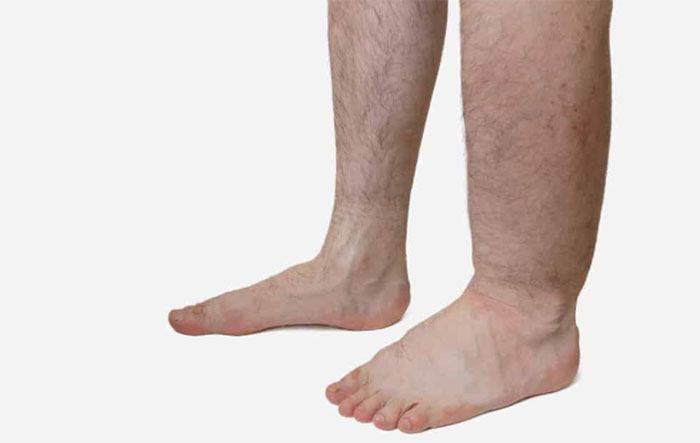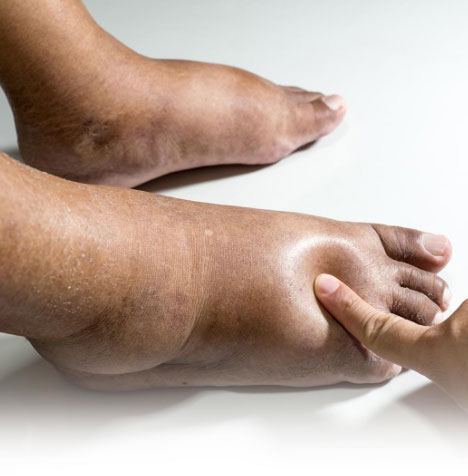Elephantiasis, also known as lymphatic filariasis, is a complication caused by lymphatic filarial infection. This disease is primarily prevalent in humid tropical countries and occurs due to mosquitoes transmitting filarial larvae to humans.
Essential Information About Elephantiasis
Filarial worms parasitize the lymphatic system, leading to damage to lymphatic vessels and causing fluid accumulation, resulting in the condition known as elephantiasis.
Treatment for elephantiasis depends on the disease’s stages, with the most effective outcomes occurring in the early stages. However, early-stage symptoms are often subtle and easily overlooked. In advanced stages, especially when complications arise, treatment outcomes may be limited, and surgical intervention may be necessary in some cases.

The cause of elephantiasis is due to filarial worms.
Causes of Elephantiasis
The cause of elephantiasis is filarial worms. Worldwide, three species of filarial worms have been identified that cause disease in humans: Wuchereria bancrofti (W. bancrofti), Brugia malayi (B. malayi), and Brugia timori (B. timori). In our country, only two species have been identified: W. bancrofti and B. malayi.
Characteristics
The species W. bancrofti typically resides in the lymphatic system of the groin or armpits. Mature W. bancrofti worms resemble thin, opaque threads, measuring 25-40 mm in length and approximately 0.1 mm in diameter. Female W. bancrofti worms can reach lengths of 60-100 mm.
The larvae of B. malayi have a preference for the genital lymph nodes and kidney areas. Morphologically, B. malayi is similar to W. bancrofti, with males measuring about 22.8 x 0.08 mm and females about 55 x 0.16 mm.
Male and female worms often coil around each other, obstructing lymphatic flow.
Survival in the Environment:
Both filarial larvae and adult worms do not survive in the natural environment; they only exist within the human body and the bodies of disease-transmitting mosquitoes.
Symptoms of Elephantiasis
Elephantiasis is most clearly manifested during the complication phase of filarial infection. Symptoms of elephantiasis depend on the stage of the disease as follows:
- Incubation Period: This is the time from when the filarial larvae enter the body until they develop into adult worms.
- Initial Phase: Symptoms are often vague and can easily be mistaken for other diseases. Patients may experience fever and inflammation in the armpits or groin, accompanied by swollen lymph nodes.
- Full-blown Phase: At this stage, the lymphatic system has been damaged, leading to complications.
Manifestations of the full-blown phase/complications:
- Appearance of Elephantiasis: Patients will experience recurrent swelling, with the skin gradually thickening and swelling progressing from the lower to the upper extremities. Most cases involve swelling in one leg, commonly affecting the entire foot and possibly extending to the thigh. The skin becomes increasingly thick and hard, and ulcers may appear due to nutritional deficiencies.
- Genital Inflammation: This includes conditions such as inflammation of the spermatic cord, testicular inflammation, and hydrocele. In severe cases, the genital area may swell significantly, resembling an elephant’s scrotum or breast, but without redness or pain (hence referred to as elephantiasis). Genital inflammation severely impacts the patient’s quality of life, significantly reducing their ability to work and affecting their physical activities and aesthetics.
- Lymphatic Urine: The urine appears milky, resembling rice water, but does not settle over time and may sometimes contain blood. In some cases, excessive lymphatic fluid in the urine can cause it to coagulate if left to sit.
Diagnosis of Elephantiasis
Elephantiasis can be easily recognized clinically when there are symptoms of swollen limbs, but for other cases, some tests can be performed for early diagnosis.
- Blood tests: presence of filarial larvae.
- Chylous fluid tests: can detect filarial larvae.
- Immunosorbent assays using enzyme-linked immunosorbent assay (ELISA).
- Lymph node biopsy for pathological examination.
- Ultrasound and lymphangiography: to detect damage in the lymphatic system.

Swollen limbs are one of the symptoms of elephantiasis.
Treatment Methods for Elephantiasis
Treatment methods for elephantiasis include:
Complex Decongestive Therapy (CDT)
CDT is still considered the international standard of care for lymphatic swelling in general and elephantiasis in particular, consisting of two phases: attack and maintenance.
The goal of CDT is to enhance lymphatic drainage; reduce swelling, discomfort, fibrosis, and the risk of cellulitis; and improve functional status and quality of life. The attack phase includes a technique called Manual Lymphatic Drainage (MLD), short bandaging, exercises to create and strengthen the internal pumping mechanism, skin care, and education for self-management. Skin care is essential to prevent infections, control bacterial and fungal invasions, eliminate excessive bacterial growth in skin creases, and moisturize the skin to avoid dryness and cracking.
The maintenance phase typically involves wearing compression garments during the day, with patients in more advanced stages requiring nighttime compression through bandaging or using compression devices and custom compression garments. MLD and exercise continue to play a crucial role in maintaining lymphatic swelling treatment.
Surgical Methods
Although surgery is not a cure, it is sometimes considered when CDT and other methods fail to alleviate symptoms. Surgical options include excision or debulking and liposuction to help reduce excess tissue, typically reserved for patients whose mobility and quality of life are severely impaired by the disease. Additionally, newer micro-lymphatic reconstructive techniques, including lymphatic bypass, lymph node transfer, and lymphatic grafting, are gaining attention.
Transmission of Elephantiasis
Elephantiasis is not directly transmitted from an infected person to a healthy person but rather through a disease vector, which is mosquitoes. If a mosquito bites an infected person and becomes infected with larvae, it can then transmit the disease to others.
At-Risk Populations for Elephantiasis
Humid and hot climates, poor environmental sanitation, and damp living conditions create favorable environments for mosquito development, thus increasing the risk of the disease in regions with hot and humid climates.
Sleeping without mosquito nets increases the chances of mosquitoes transmitting filarial larvae into the body.
Preventing Elephantiasis
As elephantiasis is a mosquito-borne disease, prevention plays a crucial role in reducing incidence rates: To prevent the disease, the following measures should be implemented:
- Regularly clean the surrounding environment, clear bushes, unblock drains, and dispose of broken containers around the house.
- Avoid mosquito bites by sleeping under nets, wearing light-colored clothing, and wearing long pants and long-sleeved shirts in the evening to minimize mosquito exposure.
- Eliminate mosquitoes and destroy disease sources: participate in campaigns organized by authorities to eradicate mosquitoes.
Developing artificial skin from mushrooms that resembles real skin
After years of difficulty breathing, a man discovers a strange object growing in his nose
The sense of smell is the fastest danger warning system in humans


















































